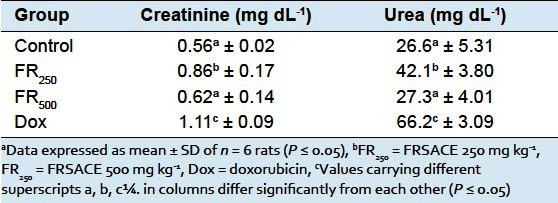1. Priestman T. Cancer chemotherapy in clinical practice. London: Springer-Verlag; 2008.
2. Ng R, Better N, Green MD. Anticancer agents and cardiotoxicity. Semin Oncol. 2006;33:2–14.[PubMed]
3. Lui RC, Laregina MC, Herbold DR, Johnson FE. Testicular cytotoxicity of intravenous doxorubicin in rats. J Urol. 1986;136:940–3. [PubMed]
4. Injac R, Strukelj B. Recent advances in protection against doxorubicin-induced toxicity. Technol Cancer Res Treat. 2008;7:497–516. [PubMed]
5. Ratain MJ, Ewesuedo RB. Cancer chemotherapy. Berlin: Springer-Verlag; 1999. pp. 76–83.
6. Quiles JL, Huertas JR, Battiono M, Mataix J, Ramírez-Tortosa MC. Antioxidant nutrients and adriamycin toxicity. Toxicology. 2002;180:79–95. [PubMed]
7. Ananymous. The Wealth of India. Vol. 4. New Delhi: Council of Scientific and Industrial Research; 1952. pp. 35–6.
8. Ahmed F, Urooj A. Antioxidant activity of various extracts of Ficus racemosa stem bark. National Journal of Life Sciences. 2009;6:69–74.
9. Ahmed F, Urooj A. Glucose lowering, hepatoprotective and hypolipidemic activity of stem bark ofFicus racemosa in streptozotocin-induced diabetic rats. J Young Pharm. 2009;1:160–4.
10. Ahmed F, Hudeda S, Urooj A. Antihyperglycemic activity of Ficusracemosa bark extract in type II diabetic individuals. J Diabetes. 2010;3:1–2.
11. Ahmed F, Sharanappa P, Urooj A. Antibacterial activities of various sequential extracts of Ficusracemosa stem bark. Pharmacognosy Journal. 2010;2:203–6.
12. Ahmed F, Chandra JN, Manjunath S. Acetylcholine and memory enhancing activity ofFicusracemosa bark. Pharmacognosy Res. 2011;3:246–9. [PMC free article] [PubMed]
13. Ahmed F, Siddesha JM, Urooj A, Vishwanath BS. Radical scavenging and angiotensin converting enzyme inhibitory activities of standardized extracts of Ficusracemosa stem bark. Phytother Res.2010;24:1839–43. [PubMed]
14. Ahmed F, Urooj A. Hepatoprotective effects of Ficusracemosa stem bark against carbon tetrachloride-induced hepatic damage in albino rats. Pharm Biol. 2010;48:210–6. [PubMed]
15. Ahmed F, Urooj A. Cardioprotective activity of standardized extract of Ficusracemosa stem bark against doxorubicin-induced toxicity. Pharm Biol. 2012;50:468–73. [PubMed]
16. Ellman GL. Tissue sulfhydryl groups. Arch Biochem Biophys. 1959;82:70–7. [PubMed]
17. Ohkawa H, Ohishi N, Yagi K. Assay for lipid peroxides in animals tissues by thiobarbituric reaction.Anal Biochem. 1979;95:351–8. [PubMed]
18. Herman EH, Ferrans VJ. Animal models of anthracycline cardiotoxicity: Basic mechanisms and cardioprotective activity. Prog Pediatr Cardiol. 1998;8:49–58.
19. Au WW, Hsu TC. The genotoxic effects of adriamycin in somatic and germinal cells of the mouse.Mutat Res. 1980;79:351–61. [PubMed]
20. Sawada T, Tamada H, Mori J. Secretion of testosterone and epidermal growth factor in mice with oligozoospermia caused by doxorubicin hydrochloride. Andrologia. 1994;26:151–3. [PubMed]
21. Imahie H, Adachi T, Nakagawa Y, Nagasaki T, Yamamura T, Hori M. Effects of adriamycin, an anticancer drug showing testicular toxicity, on fertility in male rats. J Toxicol Sci. 1995;20:183–93.[PubMed]
22. Goodman J, Hochstein P. Generation of free radicals and lipid peroxidation by redox cycling of adriamycin and daunomycin. Biochem Biophys Res Commun. 1977;77:797–803. [PubMed]
23. Pritsos CA, Sokoloff M, Gustafson DL. PZ-51 (Ebselen) in vivo protection against adriamycin-induced mouse cardiac and hepatic lipid peroxidation and toxicity. Biochem Pharmacol. 1992;44:839–41.[PubMed]
24. Shinozawa S, Gomita Y, Araki Y. Protective effects of various drugs on adriamycin (doxorubicin)-induced toxicity and microsomal lipid peroxidation in mice and rats. Biol Pharm Bull. 1993;16:1114–7.[PubMed]
25. Mansour MA, El-Kashef HA, Al-Shabanah OA. Effect of captopril on doxorubicin-induced nephrotoxicity in normal rats. Pharmacol Res. 1999;39:233–7. [PubMed]
26. Manabe F, Takeshima H, Akaza H. Protecting spermatogenesis from damage induced by doxorubicin using the luteinizing hormone-releasing hormone agonist leuprorelin: An image analysis study of a rat experimental model. Cancer. 1997;79:1014–21. [PubMed]
27. Patil LJ, Balaraman R. Green tea extract protects doxorubicin induced testicular damage in rats.Pharmacologyonline. 2008;3:913–25.
28. El-Shenawy NS, Abdel-Nabi IM. Hypoglycemic effect of Cleome droserifolia ethanolic leaf extract in experimental diabetes, and on non-enzymatic antioxidant, glycogen, thyroid hormone and insulin levels. Diabetologia Croatica. 2006;35:15–22.
29. El-Shitany NA, El-Haggar S, El-desoky K. Silymarin prevents adriamycin-induced cardiotoxicity and nephrotoxicity in rats. Food Chem Toxicol. 2008;46:2422–8. [PubMed]
30. Saad SY, Najjar TA, Al-Rikabi AC. The prevention role of deferoxamine against acute doxorubicin-induced cardiac, renal and hepatic toxicity in rats. Pharmacol Res. 2001;43:211–8. [PubMed]
31. Khan N, Sultana S. Chemomodulatory effect of Ficusracemosa extract against chemically induced renal carcinogenesis and oxidative damage response in Wistar rats. Life Sci. 2005;29:1194–210.[PubMed]
|









